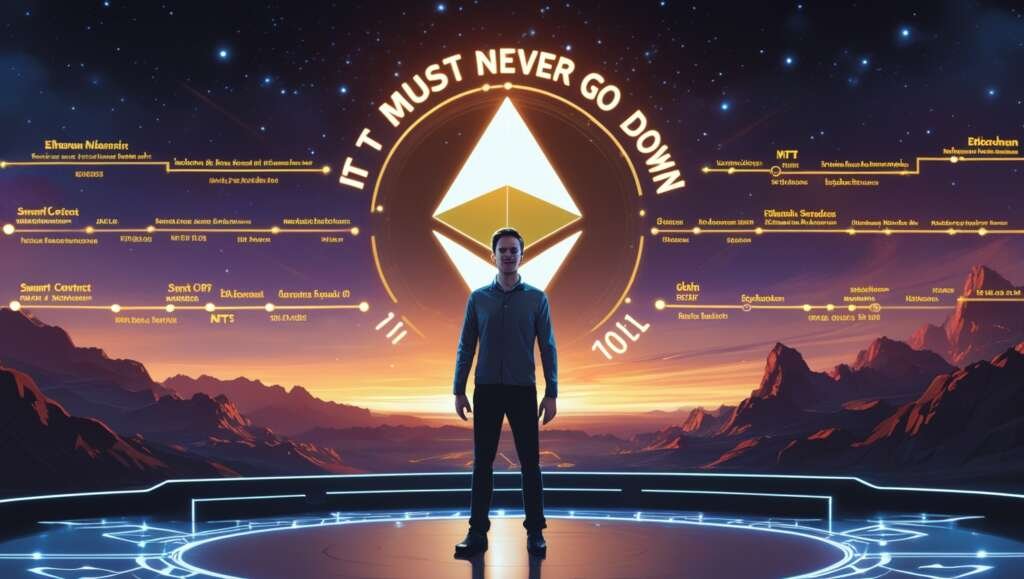On the occasion of the network’s 10th anniversary, Ethereum co-founder Vitalik Buterin shared his hopes and excitement for the next decade during the anniversary livestream. The tech genius celebrated a decade without downtime, and in honor of that milestone, he reaffirmed that the Layer1 Blockchain must never go down.
He talked about the network’s resilience during forks, having undergone 16 major upgrades since launch, hacks, lawsuits, and global crises, and how they strengthened the community. Ethereum has thrived since its launch, powering DeFi and becoming a pioneer for dApps. Vitalik Buterin has more than enough reasons to celebrate the network’s success.
Five Things Vitalik Buterin Talked About in His Interview Amid Anniversary Celebration
Buterin made some resounding affirmations that Ethereum must never go down. He prominently retweeted a post by fellow contributor Binji, which celebrated 10 years of uninterrupted service despite outages in centralized systems like AWS and Facebook. In his viral message about Ethereum’s uninterrupted service delivery, he said the feat was achieved because of his dedicated community.
He recalled that the original thought was to create an open space for global developers—one where anyone could freely build applications and express their creativity. He further stated that Ethereum’s core mission is to continue advancing human progress and safeguarding people’s digital autonomy, which requires the network to remain online and never go down. Over the past decade, Ethereum has withstood numerous challenges, undergoing 16 major upgrades and processing billions of transactions—all without a single moment of downtime.
Despite that, Buterin stressed the importance of scaling Ethereum’s layer by 10x over the next year, citing new tech infrastructure like Proto-Danksharding to minimize gas costs and support millions more users. He stressed the need to increase gas limits to facilitate thousands more transactions directly on the L1 chain.
Vitalik Buterin Talks About Privacy and Mirroring Bitcoin Layer
The Ethereum co-founder also talked about privacy as a foundational requirement, emphasizing the need for adoption of zero-knowledge proofs (ZKPs), single-use addresses, and secure hardware. He said adopting these with zkPassport would help reduce tracking and foster censorship resistance on Ethereum.
Buterin likened Ethereum to Bitcoin, saying he wants the L1 Blockchain to be as simple as Bitcoin, if not substantially less complex. He proposes introducing a 3-slot finality model to eradicate complexity like epochs. Additionally, he suggests replacing EVMs with more efficient VMs like RISC-V for the execution layer to reduce the maintenance burden and enable a more protocol simplification. However, compatibility will still be retained on-chain.
Arguably, the strongest remark made by Vitalik Buterin was that Ethereum must remain resolute and resilient. He suggested “walk-away” tests to ensure users’ funds remain secure in case of any attack. Furthermore, he calls for faster confirmation times and maintaining a validator count of over a million to maintain trust and long-term sustainability. Currently, Ethereum’s confirmation time is between 15 seconds to 5 minutes.
Impact of Buterin’s Roadmap Vision for Ethereum
The message behind Buterin’s interview is operational continuity. Although Ethereum’s 10 years of uninterrupted service time is a major milestone, Buterin insists that the network must never go offline, reiterating his commitment to continuity. However, Ethereum must be more scalable, less complex, and more secure simultaneously to power the new era of decentralization.
With a guaranteed simplified execution layer, privacy, and resilient uptime, trust is established among developers and institutions. Ethereum aims to transition from developer-focused to enterprise-grade infrastructure, and Buterin’s vision supports this shift. He wants the network to have a real-world impact with utilities, such as AI DAOs, voting, digital identity, and DeFi systems, citing Polymarket and prediction protocols as examples of meaningful adoption.
What’s Next for Ethereum?
It’s time for Ethereum to get to work based on Buterin’s roadmap vision. He wants the blockchain network to achieve 10x more scalability as early as next year, leaving no time for further deliberation. His anniversary remarks are a bold reaffirmation of his core ethos, which is scalability, privacy, simplification, utility, and decentralization.
The next decade will be a testing period on Ethereum’s timeline, as the platform aims to transform into a global financial infrastructure without losing compatibility and decentralization. The team may face execution complexity, balancing security and innovation, and scaling beyond its current infrastructure.




